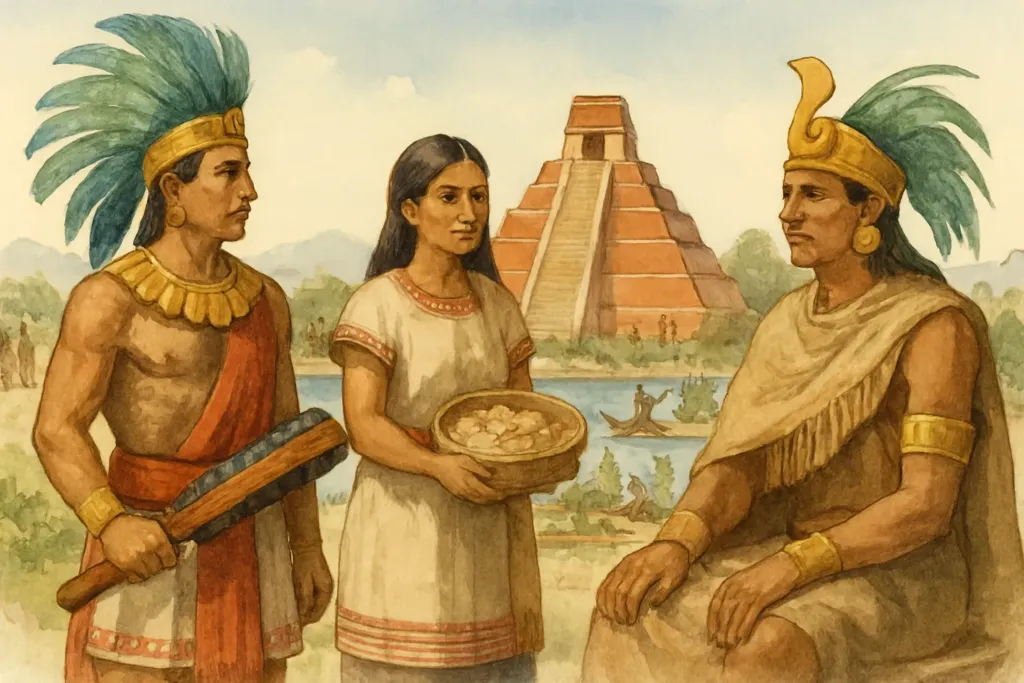«Ацтеки» — это научное название правящей элиты и населения Тройственного союза (Теночтитлан, Тескоко, Тлакопан) в Центральной Мексике в XV — начале XVI века; этнолингвистически они относятся к народу науа, говорящему на языке науатль. Религия была политеистической — Уицилопочтли, Тлалок, Тескатлипока, Кецалькоатль — с переплетёнными 260- и 365-дневными календарями. Черты характера не могут быть обобщены, но источники подчёркивают общинную взаимность, дисциплину, ритуальные обязанности и повседневное гостеприимство. Алкоголь регулировался: пульке разрешалось употреблять старейшинам и во время ритуалов, публичное пьянство каралось; психоактивные вещества (грибы теонанакатль, ипомея ололиуки, пейотль) ограничивались строго контролируемыми обрядами. Спорт включал мезоамериканскую игру в мяч; сегодня популярны футбол и баскетбол. Управление осуществлялось от родственников кальполли к городам-государствам (альтепетлям); тлатоани правили с помощью совета знати и сиуакоатля (главного администратора). Социальная стратификация включала в себя знать пипильтин, простолюдинов масеуальтин, торговцев-почтек, ремесленников, зависимых майеке и рабов-тлакотин.
История
Согласно традиции, мешики мигрировали из Ацтлана и основали Теночтитлан в 1325 году на островах озера Тескоко. В XV веке при Ицкоатле, Монтесуме I и идеологе Тлакаэлеле Тройственный союз расширился, объединяя регионы посредством дани и войн. Численность населения столицы составляла около 200–250 тысяч человек, она была связана дамбами и акведуками; поля чинампы давали высокие урожаи. В 1519–1521 годах Эрнан Кортес, при решительной поддержке Тласкалы и других имперских соперников, и в разгар эпидемий (оспы в 1520 году), захватил город 13 августа 1521 года. Колониальное правление преобразовало институты, однако общины науа сохранили язык, обычаи и общинные земли, адаптировавшись к новой религиозной и административной системе.
Название
Слово «ацтек» происходит от слова «Ацтлан», мифического места происхождения. Правители и жители столицы называли себя мешика (теночка), в то время как более широкая языковая семья — науа. Само слово «мексика» происходит от слова «мексика», что дало названия стране и столице.
Занятия
В доколониальный период основными промыслами были сельское хозяйство (кукуруза, фасоль, амарант, тыква, перец чили), изготовление чинамп, ремёсла (обсидиан, керамика, текстиль, изделия из перьев) и междугородняя торговля (почтека) (какао, хлопок, нефрит). Система дани перераспределяла товары в столицу. Сегодня народ науа занимается смешанной экономикой — земледелием и садоводством, наёмным трудом, ремёслами, туризмом и образованием — наряду с языковым и культурным возрождением.
Описание внешности
Ацтеки — коренные жители Мезоамерики. В описаниях упоминаются тёмные волосы, карие глаза, оттенки кожи от светлого до тёмно-оливкового и рост мужчин доколумбовой эпохи около 1,60–1,65 м (современные средние показатели выше благодаря правильному питанию и здравоохранению). Фенотипы различаются в зависимости от региона и вековой истории межрасовых браков; жёсткие «расовые» категории вводят в заблуждение.
Географическое распространение
Историческое ядро империи располагалось на Центрально-Мексиканском нагорье: долина Мехико и современные штаты Мехико, Морелос, Пуэбла, Идальго, Веракрус, Герреро. Влияние империи распространялось на оба побережья. Сегодня общины науа сосредоточены в центральной и восточной Мексике, родственные им пипили/наваты находятся в Сальвадоре, а диаспоры — в мексиканских городах и США.
Войны и конфликты
Империя регулярно проводила кампании за дань и пленников; «цветочные войны» с Тласкалой и Уэхоцинго служили ритуальным и политическим целям. Их силы определялись боевыми орденами воинов-ягуаров и орлов, оружием, таким как макуауитль с обсидиановым лезвием, дротиками с атлатлем, щитами и стегаными хлопковыми доспехами. Внутренние противоречия возникали из-за налогообложения и наследования. Победа испанцев зависела от союзов с коренными народами и эпидемий.
Население
Накануне завоевания население империи исчислялось миллионами; оценки численности населения Мезоамерики значительно варьируются в пределах десятков миллионов. В XVI веке демографический спад составил 70–90% из-за болезней Старого Света (оспы, кори, тифа) и социальных потрясений. В современной Мексике насчитывается около 1,5–1,7 миллиона носителей языка науатль, причём в некоторых регионах численность населения стабилизировалась или выросла благодаря усилиям по возрождению культуры и естественному приросту.
Традиции, обряды и праздники
Календари объединяли 260-дневный тональпоуалли и 365-дневный шиупоуалли (18 «месяцев» по 20 дней плюс 5 «пустых» дней). Праздники включали танцы, подношения и пышные шествия. Погребения включали как ингумацию, так и кремацию с погребальным инвентарём. Жертвоприношения — от животных до людей — соответствуют космологии поддержания солнца и богов; сегодня общины науа отмечают синкретические католическо-аборигенные праздники, День мертвых и местные праздники святых покровителей.
Мифы и легенды
Основные мифы включают переселение из Ацтлана, орла на кактусе над водой как предзнаменование основания Теночтитлана, эпоху «Пяти Солнц», рождение Уицилопочтли в Коатепеке и Кецалькоатля как культурного героя, носителя искусств и календарей.
Нет стабильность
Известные личности: Ицкоатль (реформатор), Моктесума I и Ауисотль (расширители), Моктесума II (при контакте), Тлакаэлель (архитектор идеологии), Несауалькойотль из Тескоко (поэт-король). Ла Малинцин (Малинче) была посредником между Кортесом и индейскими политиями. Основополагающие источники включают Флорентийский кодекс Саагуна; ацтеки появляются в фресках Риверы, романах и популярных медиа, от исторической прозы до стратегических игр. Современные голоса науа включают поэта-активиста Наталио Эрнандеса Шокойоцина.
Еда
Основными продуктами питания были кукуруза (тортильи, тамале, атоле), фасоль, кабачки, амарант, чили, помидоры; белки из индейки, озерной рыбы и насекомых; Среди напитков были какао «чоколатль», пульке и поцолли. Многие продукты питания — кукуруза, помидоры, какао и ваниль — стали популярными во всем мире.
Одежда
Мужчины носили макстлатль (набедренную повязку) и плащ тильматли; женщины — юбки и уипиле. Ткани варьировались от волокон агавы до хлопка; элита предпочитала изысканные ткани, перья кетцаля и украшения; сандалии были кактли. Воинские регалии символизировали ранг и порядок.
Туризм
Ключевые достопримечательности: руины и музей Темпло Майор в Мехико, Национальный музей антропологии, Тлателолько, Чолула (завоёванная ацтеками), Малиналько. В чинампах Сочимилько проводятся экскурсии по каналам. В регионах науа есть культурные центры, мастерские по изготовлению изделий из перьев и тканей, а также гастрономические фестивали.
Этикет посетителей
Относитесь к священным местам и церемониям с уважением; спрашивайте разрешения, прежде чем фотографировать людей или ритуалы. Поддерживайте местных мастеров напрямую. Избегайте шуток и сенсационности о жертвоприношениях и завоеваниях; это деликатные исторические темы. Не выносите артефакты и не повреждайте памятники. Несколько слов на науатле и испанском будут приняты с благодарностью.
- Morocco
- Egypt
- Mammoths and travel: where to see habitats, traces and digs, and museums
- BMW: путешествие по следам легендарного бренда
- Chechnya
- The World of Varans
- Uzbekistan
- Bosphorus
- Turkmenistan
- Wrangel Island
- Macau
- How to Get Around Australia
- Indonesia
- Brest (Belarus)
- Sri-Lanka
- Niger
- Win a four-night Greek getaway for two in one of the most stylish resorts in the Aegean courtesy of Sani Resort
- Nanai
- Georgia
- Unadsdalur Church

 United States
United States